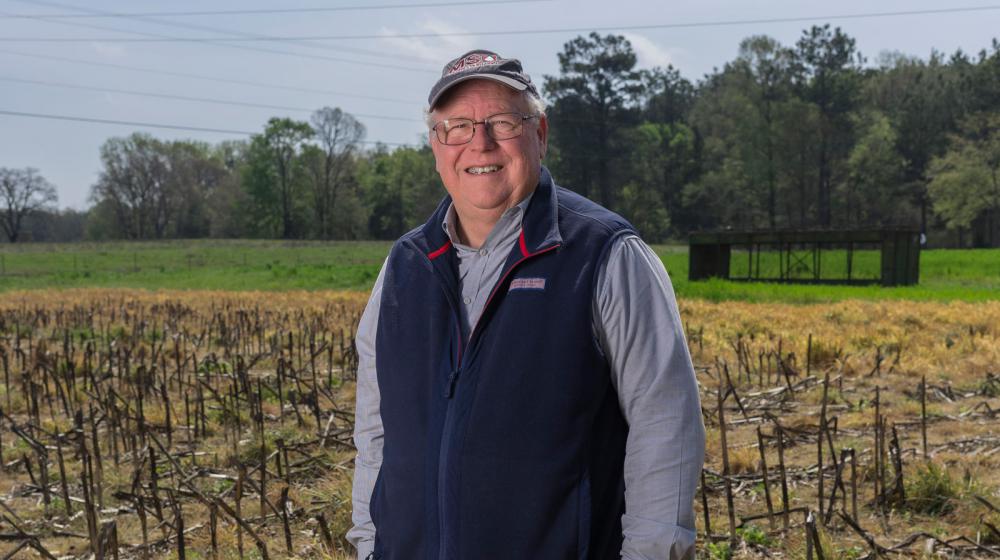Life in the Soil

Sledge Taylor, owner of Buckeye Farms
Como-based producer succeeds with sustainable ag
Story by Nathan Gregory • Photos by Kevin Hudson
One Good Idea for Farmers
Taylor’s conservation efforts are highlighted online at One Good Idea, a web-based platform for farmers to share practical ideas and learn from other farmers though videos and podcasts. Topics at https://goodideafarm.org include cover crops, conservation tillage, rotational grazing, and nutrient management.
Click here to watch Sledge talk about some good ideas at his farm.
Join the conversation by tagging #WhatsYourGoodIdea on Twitter and/or Facebook.
Sledge Taylor is no stranger to cover crops —he first planted vetch on 100 acres of his Panola County farmland in 1979—but he has ramped up his cover crop usage and added other sustainable agricultural practices over the past 15 years.
A brief tour of his operation, which he named Buckeye Farms, offers glimpses of predominantly row crops—cotton, soybeans, and corn—in flat fields. He also raises cattle and has his herd on steeper, sloping pastureland that is not as fertile and more prone to erosion. Even less-fertile land is tree-lined and enrolled in conservation programs.
Water-control structures, including culverts and drop pipes, have been installed over the years to further prevent erosion and flooding, and three-fourths of his farmland is no-till, to minimize soil disturbances and maintain the landscape’s soil-bound nutrients.
Because Taylor often seeks to improve his care of and use for all his acreage, he consults specialists from the Mississippi State University Extension Service in various agriculture-
related disciplines. Dr. Drew Gholson, an assistant MSU Extension professor and irrigation specialist based at the MSU Delta Research and Extension Center in Stoneville, has conducted crop variety research on Taylor’s fields.
Taylor also recently hosted Dr. Beth Baker, a specialist in natural resource conservation in agriculture with MSU Extension, for a land stewardship field day for producers. Baker discussed the impacts of Taylor’s practices on soil health, and Taylor shared his practices and the lessons he has learned with other area producers at the public educational opportunity.
“Getting a second or third opinion on anything we do makes good sense,” he explains. “Extension professionals see things I don’t see, because they’re trained in a different discipline from what I am. In this case, they had suggestions on how to improve what I was doing.
“They got down to the biology of the soil. I would see the earthworms, and that’s about it—but they found different types of bugs and fungi deeper in the soil,” he continues. “It was kind of a learning experience for me to see these people who were well trained find all these things, point them out, and explain the benefits of each one. I never thought to look that closely, but they showed me that there was so much activity and life in the soil.”
Taylor has another farming operation at the eastern edge of the Mississippi Delta, next to the Bluff Hills in Panola County. Because much of the soil can wash downstream, flowing from the hills to the Delta, Taylor’s two farms have a similar soil type: silt loam.
Baker says Taylor’s location in the Loess Plains in the Delta is a natural disadvantage.
“He has to use things like cover crops, or he will lose soil resources,” she says. “In earlier decades, there was probably a lot of land clearing, and soils not held in place could’ve led to significant gully erosion. When you see the effects, not only as a landowner but as a farmer whose land is your livelihood, it definitely changes your perspective.
“Reducing tillage is part of what Mr. Taylor does to protect the soil,” Baker continues. “I think he is naturally curious and open to new ideas. He’s done well farming for many years, and I think, alongside the business, he always has the goal that he wants to be the best steward of his land and water resources that he can be with the land he has.”
Taylor chalks up his success to an ongoing quest to identify and implement sustainable practices.
“I think we as farmers have to have the mindset that we don’t know it all, and there’s things we can still learn,” he says.



